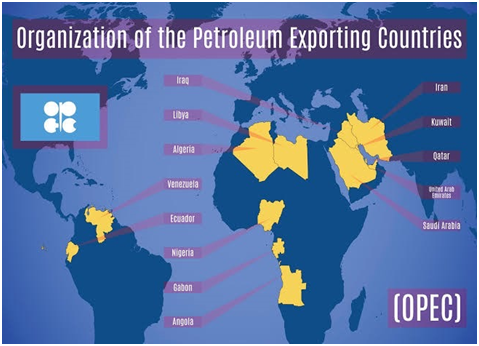Organization of the Petroleum Exporting Countries
Context: Major oil-producing countries including Saudi Arabia, Iraq, the United Arab Emirates, as well as Russia, have announced cuts in oil production that will start in May and last until the end of 2023.
What is OPEC and OPEC+?
- OPEC was formed in 1960 and its 13 current member states hold more than 80% of the world’s proven oil reserves.
- Another 10 major oil producing countries including Russia have aligned with the group to form an alliance known as OPEC+.
- OPEC produces about 40% of the world’s crude oil and its members’ exports make up around 60% of global petroleum trade.
- The group aims to regulate global oil prices by coordinating on reductions or increases in production.
Why are OPEC+ countries cutting crude oil production?
- According to OPEC’s official statement, the decision to cut crude oil production was aimed at supporting market stability. In February 2023, Russia announced it would cut crude oil production by half a million barrels a day after Western countries capped the price of its crude as a response to the war in Ukraine.
- The G-7 bloc of advanced economies announced a price cap of $60 per barrel for Russian crude oil in December 2022.
- Also, recent developments in the banking sector in the U.S. and Europe, including the collapse of the Silicon Valley Bank and the turmoil at Credit Suisse, have fuelled the possibility of an incoming recession.
- In March 2023, oil prices slipped 1% to a two-week low, on speculation of a recession and therefore a reduction in oil demand.
- Experts believe that cutting production will lead to increase in costs of crude oil in the international market.
- A sudden jump in both Brent crude and the U.S. West Texas Intermediate (WTI) crude prices — both leading global oil benchmarks — was observed in the wake of the announcement of the decision to reduce production.
Are the output cuts significant?
- As per the latest voluntary production adjustment, Saudi Arabia will be cutting 5,00,000 barrels a day; Iraq 2,11,000; United Arab Emirates 1,44,000; Kuwait 1,28,000; Kazakhstan 78,000; Algeria 48,000; Oman 40,000; and Gabon 8,000 barrels a day.
- These cuts are in addition to the two million barrels per day cut announced in October 2022. Russia had already announced a cut of 5,00,000 barrels a day, earlier this year.
- The U.S. called OPEC’s decision “unadvisable”. “Our focus is going to remain on making sure that energy markets are able to support a growing economy and keep prices down for Americans as they head to the pump.
Impact on India
- According to the World Energy Outlook 2021 data, India ranks third in the world in crude oil imports after China and the U.S., while it ranks a distant 21 in crude oil production and 26 in natural gas production.
- The disparity in the two rankings shows the country’s increasing reliance on imports to meet its energy needs.
- India’s crude oil import from Russia touched new heights in February this year, reaching 1.6 million barrels per day. This was more than the combined imports from conventional suppliers like Iraq and Saudi Arabia. At the same time, supply from Iraq and Saudi Arabia touched a 16-month low.
- Russia’s increased share in India’s crude oil import is a direct consequence of the fallout between Russia and western countries following its Ukraine invasion that began in February 2022.
- The U.S. and countries in Europe decided not to buy crude oil from Russia in a bid to isolate the country on an international scale. The decision, however, provided India with an opportunity to buy Russian oil, reportedly at discounted rates.
| Practice Question
1. What is OPEC and OPEC+ ? How the recent decision of the organisation impact the world economy. |




